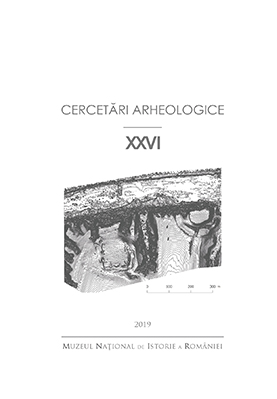Hostes ante portas! Cercetări arheologice recente asupra turnurilor porții principale de la Capidava
Hostes ante portas! Recent archaeological research on the towers of the main gate from Capidava
Author(s): Ioan C. Opriș, Alexandru RațiuSubject(s): Archaeology
Published by: MUZEUL NAȚIONAL DE ISTORIE A ROMÂNIEI
Keywords: Roman Army; Lower Danube; Roman frontiers; fortifications; castellum; limes Scythicus; 2nd -7th century AD;
Summary/Abstract: The preventive excavations of the entire complex of the southeastern gate (main gate) of the Capidava fort took place during August-September 2015 (more precisely 13.08-05.09.2015) and was part of a general investigation on the precincts and towers of the Late Roman fort. The respective project was entitled Restoration, consolidation, protection, conservation and enhancement of the archaeological site Capidava fort. It belongs to the Regional Operational Program 2007-2013, Priority Axis 5, Major Field of intervention 5.1. The beneficiary of the project are the Constanța County Council and the appointed general designer SC Abral Art Product SRL, under the coordination of architect Ioan Aurel Botez (head of project) and architect Anișoara Sion (head of project). Despite the fact that the area and the period of the excavation might seem reduced, the research was intensive and undoubtedly represents an essential contribution to the evolution of the Roman and the Romano-Byzantine fortifications from Capidava.To summarize, the results of the investigation revealed four constructive phases of the gate tower: the first phase dates from the 2nd century to the first half of the 3rd century AD and had ended violently during the great Gothic invasions that took place in mid-3rd century AD. Phase 2 dates from the second half of the 3rd century, sometime between the reign of emperors Aurelianus, Probus and Diocletian (284-305), enclosing the remains of the previous tower and having a much larger front. It is the stage that corresponds to the erection of smaller U-shaped towers (towers 3, 5 and 9), along the eastern and southern enclosures. Phases 3 and 4 were built either to follow or in some places to amplify the limits of the previous phase. Their dating covers the 4th century, respectively the last part of the 5th to the beginning of the 6th century AD. The last construction phase most likely happened sometime during the reign of emperor Anastasius (491-518), also involved in the repair of Precinct H, attached to the gate tower. This construction logic ended during the 9th decade of the 6th century after the dramatic attacks that occurred during 582-586 AD, when the precincts G and H together with the gate and the gate tower, have been destroyed. Sometime, at the end of the 6th century – the beginning of the 7th century AD. (these events took place after 595/596 or maybe even in the time of Emperor Phocas) a „late castellum” was hastily erected in the southern quarter of the fort, an ephemeral defensive ensemble. The heroic „life among ruins” and precarious living structures lasted until the second decade of the 7th century as proven by a last follis, issued under Emperor Heraclius and dated around 612/613 AD.The re-documenting and redefining of all levels of construction of the military precinct brought new, precious information, allowing multiple interpretations and associations of dramatic events in the history of the Lower Danube limes throughout early 2nd to early 7th century.
Journal: Cercetări Arheologice
- Issue Year: XXVI/2019
- Issue No: 1
- Page Range: 124-156
- Page Count: 33
- Language: Romanian

